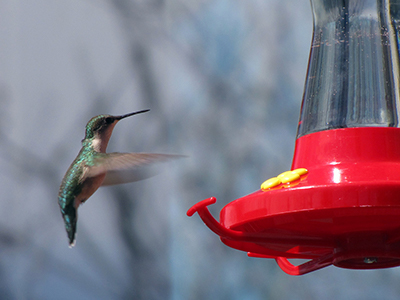Hummingbird tip’s & trick’s for Florida landscapes
Time to add a little nature to your landscaping with humming bird feeders this month for your enjoyment. We will discuss how to go about purchasing or building your very own.
Hummingbird Feeders

A hummingbird approaches the feeder.
Photo courtesy of Annkatrin Rose. (CC BY-NC-SA 4.0)
While the best source of food for hummingbirds is one of the many nectar-producing plants they love, a hummingbird feeder can be a great way to provide extra sustenance to these fast-moving little birds. Hummingbirds need to eat a third to half of their body weight each day in order to keep those rapidly beating wings moving.
When shopping for a hummingbird feeder, choose one that has red plastic fixtures and multiple feeding stations. The reason color is so important is that hummingbirds are especially attracted to red flowers. A multi-station feeder is preferable to a single glass tube or spout feeder. Be sure to choose one that lets you keep an eye on the nectar level.
When mixing up nectar for your hummingbirds, only use an unaltered solution of sugar and water. You may have seen some people dye their sugary solution red; however, artificially dyed food is not ideal for hummingbirds. To make the solution for your feeder, just remember that the recipe is “at hand”—your thumb is your one part sugar and your other four fingers are the four parts water in which you’ll dissolve the sugar.
Hang your feeder where you can enjoy the show of these little birds hovering midair to feed. With that in mind, be sure check your feeder to see if the solution becomes moldy or runs out. You should change the syrup solution and clean your hummingbird feeder every 4 to 5 days, moldy or not. Clean the feeder with hot water and a little soap. Be sure to rinse the feeder out thoroughly before adding fresh syrup.
Even with a hummingbird feeder in your landscape, it’s still important to have nectar producing plants as well. Some include: bottlebrush, coral bean, firebush, firecrackerplant, scarlet salvia, shrimp plant, soap aloe, starburst clerodendrum. Hummingbirds eat every 10 to 15 minutes and giving them a variety of food sources is very important. Tubular, nectar-rich blooms are their favorite, and while they’re drawn to red, they will feed on any color of flower.
If you should happen to find yourself with a hummingbird and ant feeder, don’t turn to pesticides. Instead, try putting a little petroleum jelly around the openings on the feeder and along the wire that suspends the feeder. You don’t want to kill off the pests; these fascinating little birds also get protein in their diet from eating insects. To lure more “protein” to their hummingbird gardens, some gardeners leave a peeled banana near the feeder to attract fruit flies. If you want to try this, place your banana in an old mesh onion bag in order to hang it. This will help to attract them.
If you need help regarding your landscaping, we at Garden Services are fully licensed & insured to handle all your irrigation, landscaping, lawn maintenance and tree service needs whether it’s a residential, commercial landscaping or homeowner association property. If you ever have any comments or questions, please don’t hesitate to call or email me and I’ll be happy to answer any questions that you might have. Special thanks to UF/IFAS extension for some helpful information provided in this post. Until next month Happy Gardening!
